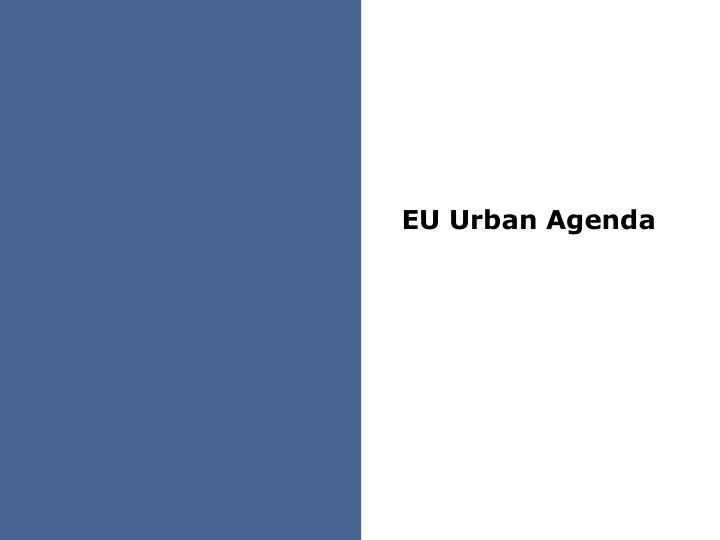



EU Urban Agenda
Overall picture Our objective is SUSTAINABLE URBAN DEVELOPMENT To do so, we need… … a vision,… We provide: Global Urban Agenda (Habitat III) EU Urban Agenda Cities of tomorrow report (2011) … concrete ideas,… We provide: URBACT ( € 96M)/ INTERREG Europe ( € 425M) (networks between cities and experts) ESPON ( € 49M) (background research) Urban Development Network (expert meetings Commission/ cities) Local urban development strategies (required under art. 7) … and money. We provide: ERDF 2014-2020 (>50% spent in cities i.e. more than € 100B) 'Article 7' ( € 15B directly managed by cities) Urban Innovative Actions ( € 371M to test new ideas)
Background • The aims of the EU Urban Agenda are: Involve cities in the design of EU/ national policies • Mobilise cities in the implementation of EU/ national policies • • Work will focus on key Priority Themes • Each Priority Theme will have an Action Plan • Work will be done by 'Partnerships' (start end 2015) • Commission + MS + Cities + NGOs/ private + experts • The Commission will facilitate the process
Background – Support of MS, EP, cities, CoR and EESC – Next steps: November 2015: Start of the 2-3 first Partnerships; May 2016: Amsterdam Pact (support by Member States); June 2016: Start of further Partnerships.
Themes- Process Consultation by the Commission (2014) • Survey UDG by the NL (July 2015) • Three Workshops by the Commission (September 2015) • Expert Urban Development Group (September 2015) • Extended Urban Agenda Working Group (October 2015) •
Themes- Selection process 1. Clearly supported by MS, COM and cities 2. Address the major challenges faced by cities 3. Require integrated action at EU-level +multi-level cooperation 4. Have the potential to generate concrete results in a reasonable timeframe. 5. Promote smart, green and inclusive cities
Themes- List 1. Jobs and skills in the local economy 2. Urban poverty 3. Housing 4. Inclusion of migrants and refugees 5. Sustainable use of land and Nature-Based solutions 6. Circular economy 7. Climate adaptation 8. Energy transition 9. Urban mobility 10. Air quality 11. Digital transition 12. Innovative and responsible public procurement
Themes- Cross-cutting issues 1. Good urban governance 2. Governance across administrative boundaries and inter-municipal cooperation 3. Sound and strategic urban planning 4. Integrated approach 5. Innovative approaches 6. Impact on societal change, including behavioural change 7. Challenges and opportunities of small- and medium-sized cities; 8. Urban regeneration 9. Adaptation to demographic change 10. Availability and quality of public services of general interest 11. International dimension
Partnerships- Rationale • Integrated approach requires: – Multi-level cooperation – Horizontal coordination – Involvement of all relevant urban stakeholders • Added value: multi-level and multi-sectoral cooperation through partnerhips between MS, cities, EC • Ownership is needed for continuity
Partnerships- Focus Better regulation: • better adapted to local action; EU rules that hinder local action (state aid and social housing), urban impact assessment Better funding: • cross-sectoral financial instruments, simplify funds, combine funds, involve cities in SIP, technical assistance Better knowledge: • improve knowledge and data (exchange), guidebooks, try and exchange innovative actions Better coordination: formulate policy orientation(s); mapping potential synergies EU programs, involve cities
Partnerships- Objectives and membership Key delivery mechanism of the EU Urban Agenda • Objective: prepare and implement an Action Plan • One Partnership for each Priority Theme • Timeframe: 3 years • Around 15 persons: • – Commission (REGIO+ EU DG) – Member States – Cities – Experts – European organisations (e.g. Eurocities/CEMR, URBACT, etc.) – Stakeholders (NGOs, etc.)
Partnerships- Governance 2 Coordinators: • – Organisation of the work (meetings, reports, etc.) – Preparing the deliverables – Link with the Commission and Member States – Link with other Partnerships – Monitoring and reporting Real commitment (up to 1FTE) • Steering Committee = DGs meeting + Commission + cities •
Partnerships- Deliverables Step n°1: Stocktaking • – Existing work (avoid duplication, create synergies) – Identification of the sources of funds Step n°2: Identify bottlenecks and potentials • Step n°3: Define the objectives and deliverables • – Action Plan – To be done in the first 6-12 months (meet every 2 months) Step n°4: Implementation of the Action Plan • – Meet at least 2 times per year
Partnerships- Support Support to the first 3-4 Partnerships: NL • Support for the next ones: Commission • NB: Meetings should be for free in existing meeting rooms • Funding of actions: • – National/ regional/ local funds – Private (e.g. banks) – ESIF – EIB
Next steps November: Start of the 3 first Partnerships • – Housing – Inclusion of migrants and refugees – Urban poverty May: Amsterdam Pact • June: Start of further partnerships •
Recommend
More recommend